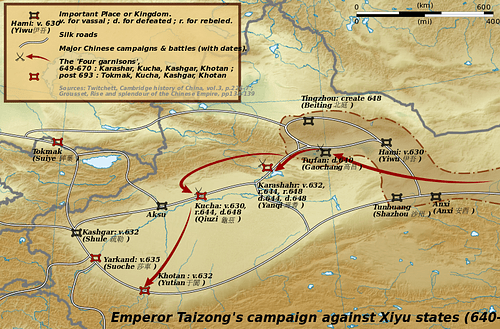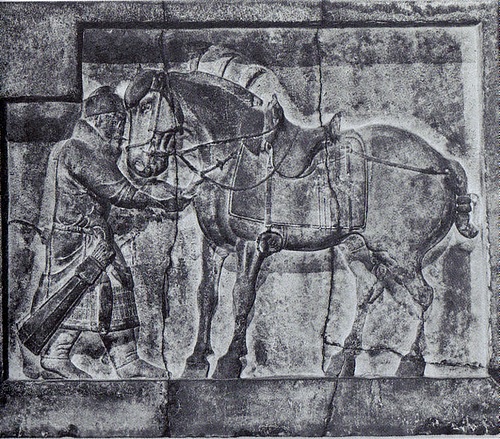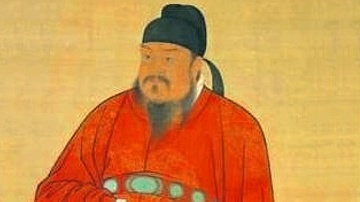
Taizong (birth name, Li-Shimin, l. 598-649 CE, r. 626-649 CE) was the second emperor of the Tang Dynasty and is considered one of the greatest rulers in Chinese history for his reforms of the government and the laws, his religious tolerance, and the prosperity China enjoyed under his reign.
Taizong set the standard for rulers of the Tang Dynasty, regarded as the Golden Age of Chinese history, which his successors were measured by. Taizong's reign became legendary to the extent that the last good emperor of the Tang Dynasty, Xuanzong II (r. 846-859 CE) modeled his own reign after that of Taizong's and was remembered after his death as "Little Taizong".
Taizong was the son of the first emperor of the Tang Dynasty, Gaozu (r. 618-626 CE) and had served under him as a general in overthrowing the rule of the corrupt Sui Dynasty (589-618 CE). Taizong was passed over for succession in favor of his older brother but staged a coup in which he murdered his brother and other siblings to seize the throne and imperial power. He proved himself such an effective ruler that these crimes were forgiven and he reigned successfully until his death when he was succeeded by his son, Gaozong (r. 649-683 CE) and then his former concubine Wu Zetian (r. 683-704 CE), the only female monarch in China's history, who learned her skills as empress from Taizong.
Li-Shimin Becomes Qin Wang
Taizong's birth name was Li-Shimin and he was born in 598 CE in modern-day Shaanxi Province, the second son of Li-Yuan. Li-Yuan was the Duke of Tang and a general in the army of the Sui Dynasty which had become more and more corrupt. In the final years, the last emperors of the Sui drained the imperial treasury on military campaigns while ignoring the needs of the people. Li-Yuan joined with other rebels to lead a revolt which overthrew the Sui Dynasty and established himself as Gaozu, first emperor of the Tang Dynasty.
According to Taizong's later personal history, he was instrumental in the most important aspects of the Tang victory by providing the tactics for his father. Taizong was a brilliant strategist and charismatic leader whose contributions to the overthrow of the Sui were rewarded when his father named him Qinguogong, a vassal of the state, and later Qin Wang, Duke of the state of Qin. As Qin Wang, he crushed the resistance to Gaozu's rule and stabilized the country.
Gaozu was a good emperor who continued the best policies of the Sui Dynasty while reducing the abuses and reforming those policies which had allowed them. It was Gaozu who implemented the bureaucratic practices which Taizong later modified and which are still used in China today. Although he ruled well, Qin Wang was becoming more popular among the people for his military actions against Sui loyalists and this concerned his brothers. Qin Wang was only the duke, not the crown prince, and his older brother Li-Jiancheng worried that he might try to replace him as heir so Li-Jiancheng conspired with the other brothers to eliminate Qin Wang.
Gaozu seemed oblivious to these problems and continued to rule well, creating the Tang Legal Code in 624 CE which would be used by future dynasties and was even copied by other nations like Japan, Korea, and Vietnam. He also reformed the aristocracy to prevent over-taxation of the peasant farmers and re-distributed land parcels. While he was busy governing the country, his sons were working on various plots to get rid of Qin Wang and secure the rightful succession. Qin Wang was told of his brothers' plans and let his father know about them. Just before this, Gaozu had named Li-Jiancheng his heir and this decree was more than Qin Wang could bear. He believed he deserved better than the position of Duke of Qin because of his efforts in putting down the Sui rebellions and due to his popularity among the people.

Qin Wang Becomes Taizong
Qin Wang heard his brothers were going to stage a coup to remove Gaozu and take the throne. They would then be able to easily murder him and Li-Jiancheng would become emperor with the brothers elevated to high court positions. Qin Wang placed soldiers loyal to him near the Xuanwu Gate of the palace, the route he knew his brothers would take, who then attacked as they were passing by and killed them all. Qin Wang was made crown prince, forced his father to abdicate to him, and was made emperor of China.
Once he was emperor, he took the name Taizong, had his oppenents executed and then used the concept of ancestor worship to his advantage and declared that all those who had been killed were now his celestial advisors. Taizong had shown himself to be such an effective general and statesman under his father's administration that no one challenged him once he took control.
Taizong's Reign
One of the first things Taizong did was to create the History Commission to chronicle the Sui Dynasty's rise and fall and how he, Taizong, had founded the Tang Dynasty. In Taizong's version of history, he had been the power behind his father all along. He then dedicated himself to proving his account by becoming a greater emperor than his father. By 630 CE he had defeated the Göktürks and taken back control of territories they had seized.
As a security measure, he banned all unauthorized foreign travel to limit the possibility of spies in the country. How effective this ban was is not known but the famous Buddhist monk and travel writer Xuanzang (602-664 CE) writes about how many checkpoints there were along the borders and how he had to talk his way past the guards at the Yumen Pass on his way to India.
In 634 CE Taizong signed a peace treaty with Tibet and gave the Tibetan king his adopted daughter as a bride. Religious tolerance and diversity in China flourished under Taizong's reign. Buddhism became widely practiced, surpassing Confucianism and curbing the popularity of Taoism. Taizong allowed the Christian missionary Alopen to preach his religion in China in 635 CE, introducing Christian concepts to the country and in 638 CE a Persian mission was allowed to establish Zoroastrian groups.
Between 638-645 CE delegates from a number of governments, including the Byzantine, came to Taizong requesting aid in stopping the militant spread of Islam but Taizong refused because he did not want to get involved in religious wars. Taizong was a devout Buddhist and believed all faiths should be able to live together peacefully.
In the same way that he welcomed all different faiths, he embraced diverse ethnicities and elevated people of different ethnic groups to positions at the imperial court. He was open to advice and listened carefully to the wisdom of his counselors. When his chancellor, Wei Zheng, pointed out over 200 mistakes the emperor had made thus far in his reign, Taizong accepted the criticism and corrected them. When he was told a military expedition would be too costly for the people, he abandoned it. He enjoyed his own company and was an accomplished poet and writer who wrote two books, Di Fan and Zhen Guan Zheng Yao (Model of an Emperor and The Emperor's Government Strategy), which would become important resources for later rulers.
Taizong & Wu Zhao
In c. 638 CE Taizong selected a beautiful 14-year-old girl, Wu Zhao, as one of his concubines. The term 'concubine' is often associated with sex, but, actually, concubines at the imperial court performed many services for the emperor such as singing, dancing, cleaning, and doing laundry. Wu Zhao was assigned laundry duty and performed her tasks well.
She knew, though, that she was meant for better things than washing other people's dirty clothes and linens and, one day, when she found herself alone with Taizong, she began talking to him as though he were anyone else in the laundry, not the most powerful man in China. Taizong was surprised that his laundress was so well-informed on Chinese history and so skilled in conversation. He soon found out she could also sing, dance, play music, write poetry, and had interesting insights on government and history. He took Wu Zhao out of the laundry and made her his personal secretary.
Wu Zhao became Taizong's constant companion at court and was involved in all of the meetings and conferences the emperor held with his counselors and foreign dignitaries. Taizong called her Mei-Niang, "beautiful girl" and kept her in attendance during all his business transactions as well as his leisure time. Wu Zhao was a keen observer who absorbed everything she experienced during these meetings and learned the skills Taizong used to govern so effectively.
She was clever and intelligent but also beautiful and she attracted the attention of many men at court. One of these men was Li Zhi, Taizong's son, who was already married at the time but fell deeply in love with Wu Zhao. She began an affair with him while still holding her position as Taizong's favorite concubine.

Military Campaigns
Taizong's military campaigns were carried out primarily between 640-649 CE against the so-called Oasis States of the Göktürks. Taizong understood that a professional military force was necessary for defense and also for expansion of his realm. Historian Justin Wintle writes:
Under Taizong, a total of 600 militia units were formed consisting of between 800 and 1200 men. Militamen, exempted from taxes, might serve either on short-term secondments to the capital or at border garrisons or in their own provinces. They were overseen by a professional corps of officers, rotated around the empire to preclude the possibility of their forming personal power bases. The Tang also maintained a standing force, the elite "Northern Army", barracked outside the capital. These and related measures were costly, but for 150 years they paid for themselves by enabling the empire to expand commercially as well as territorially without the distractions of internal revolt. (143)
Taizong sent his army against the Eastern Turkic Khaganate in the Tarim Basin after diplomatic measures failed. Originally, relations between the Tang Dynasty and the city of Gaochang had been warm. The king of Gaochang, Qu Wentai, visited Taizong at Chang'an in 630 CE but a dispute arose between Gaochang and a neighboring town of Yanqi which erupted into hostilities and caused Taizong to declare war.
The town of Yanqi was on a trade road which wound through the desert to important centers in China. The road was closed by Taizong to prevent its use by spies or rebels and the merchants from Yanqi had to travel through Gaochang to reach China. These merchants began trading in Gaochang instead of making the longer journey into China. The king of Yanqi, Long Tuqizhi, sent an emissary to Taizong requesting the road be re-opened because his merchants were not getting the kinds of prices for their goods in Gaochang that they used to in Chang'an.
Taizong agreed to the request and the road was re-opened but this angered Gaochang who attacked Yanqi. King Qu Wentai of Gaochang then allied himself with tribes hostile to the Tang Dynasty and raided further Yanqi settlements, destroying towns, and capturing citizens for ransom or sale as slaves.
Taizong sent an emissary to Gaochang asking Qu Wentai to send an emissary in return to discuss the situation. Instead of honoring Taizong by sending the emissary specifically requested, Qu sent a lower official and entered into further treaties with cities hostile to Tang rule. In 640 CE, Taizong sent his general Hou Junji to break the power of Gaochang and force Qu Wentai to obey Tang edicts. When Qu Wentai heard that the great Tang army was marching on his city he died, most likely from a heart attack. His son Qu Zhisheng succeeded him and quickly wrote to General Hou apologizing for Gaochang's past behavior and promising better relations in the future. Hou Junji rejected this appeal and demanded that Qu Zhisheng surrender unconditionally. Qu Zhisheng refused and General Hou attacked Gaochang.
The army of Qu Zhisheng was no match for the highly trained Tang army and the city fell quickly. Taizong then annexed the territories and garrisoned them with troops. The problems with Gaochang were solved but now the Yanqi allied themselves with the Western Turkic Khaganate and declared themselves hostile to Tang interests in c. 644 CE. Taizong defeated them and claimed their land and then sent the army further to subdue the Eastern Turks, finally claiming the whole of the Tarim Basin as part of his realm by 648 CE.
Taizong's Death & Legacy
Taizong contracted dysentery and died in 649 CE. He was buried with great ceremony in his home province in a tomb known as the Zhao Mausoleum. Li Zhi succeeded him as emperor and took the name Gaozong. Gaozong would have to continue his father's wars in the Tarim Basin as the turks revolted and the Tang army was sent to put the rebellions down. Following Taizong's death, all of his concubines had their heads shaved and were sent to live out the rest of their lives in a monastery. Gaozong was so in love with Wu Zhao, though, that he had her brought back to the palace and made her his first concubine. She became the power behind the throne from as early as 660 CE and when Gaozong died in 683 CE Wu Zhao seized power and became the empress Wu Zetian.
Even though many aspects of her reign were harshly criticized by later Chinese historians, Wu Zetian followed Taizong's example in many ways and improved on his policies. Wu Zetian laid the foundation for the next great emperor of China, Xuanzong (r. 712-756 CE), under whose reign the Tang Dynasty would reach its greatest height. Although her accomplishments were all her own, she had learned her skills from Taizong.
Taizong became the model emperor who set the standard for every other successful ruler who followed him. His name was always invoked in praise for his policies and he is still considered one of the greatest rulers in Chinese history. The other emperors of the Tang Dynasty were measured by how closely they met the standards of Taizong and very few, possibly none, ever exceeded them.
Almost every other Tang ruler, including the successful Wu Zetian and Xuanzong who followed directly after him, lost sight of their responsibility to the people and the land and indulged in their own private pleasures. Taizong remained faithful to his responsibilities from the time he assumed control of the government until his death and so continues to be regarded with honor as the model of a great emperor.







